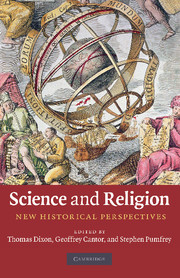Book contents
- Frontmatter
- Contents
- List of contributors
- Preface
- 1 Introduction
- PART I CATEGORIES
- PART II NARRATIVES
- PART III EVOLUTION AND CREATIONISM
- PART IV THE POLITICS OF PUBLISHING
- PART V WAYS FORWARD
- 12 Sciences and religions: what it means to take historical perspectives seriously
- 13 Simplifying complexity: patterns in the history of science and religion
- 14 What shall we do with the ‘Conflict Thesis’?
- Select bibliography
- Index
12 - Sciences and religions: what it means to take historical perspectives seriously
Published online by Cambridge University Press: 05 May 2010
- Frontmatter
- Contents
- List of contributors
- Preface
- 1 Introduction
- PART I CATEGORIES
- PART II NARRATIVES
- PART III EVOLUTION AND CREATIONISM
- PART IV THE POLITICS OF PUBLISHING
- PART V WAYS FORWARD
- 12 Sciences and religions: what it means to take historical perspectives seriously
- 13 Simplifying complexity: patterns in the history of science and religion
- 14 What shall we do with the ‘Conflict Thesis’?
- Select bibliography
- Index
Summary
INTRODUCTION: A FIRST ENCOUNTER WITH BROOKE'S HISTORIOGRAPHY
It was by accident that I first encountered Science and religion: Some historical perspectives (1991). The monastic scholar's cell I had been assigned as a doctoral student crafting a dissertation proposal was in the university library. A rack of newly acquired books stood by the library entrance, and on my way in each morning I absent-mindedly scanned the fresh arrivals. One morning late in the spring of 1991 my eyes settled on the lime-on-black cover of Science and religion. The book had not been there the day before; since it had not yet been catalogued and bar-coded, I could not borrow it. Instead, I settled onto the carpet, where I remained until evening, when my wife, who was studying to be a physician, took me home.
The person she found crumpled on the carpet was different from the one she had kissed goodbye ten hours earlier. I knew immediately that, with this book, my world had shifted on its axis. In 1991 it was still possible for a graduate student to frame a research project asking the same questions as those posed fifty-five years earlier by Robert Merton. In my case, embarking on a dissertation about Jews' attitudes towards sixteenth-century astronomy, I asked whether or not the ‘cultural soil’ of high central European Ashkenazi Jewish culture was – as Merton had found of seventeenth-century England – ‘peculiarly fertile for the growth and spread of science’.
- Type
- Chapter
- Information
- Science and ReligionNew Historical Perspectives, pp. 247 - 262Publisher: Cambridge University PressPrint publication year: 2010
- 3
- Cited by



